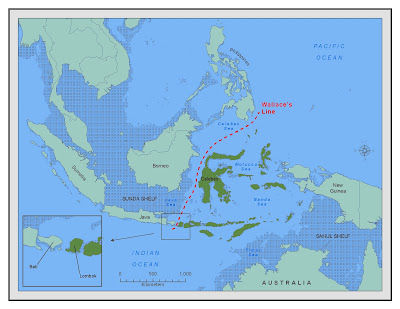Alfred Russel Wallace (1823-1913) was a Anglo-Welsh naturalist and surveyor jointly credited with Charles Darwin for the theory of Natural Selection. Despite being from considerably more humble origins than Darwin he was a gifted scientist, publishing his first scientific paper at the age of 19, and mounting a number of self funded expeditions to South America (along with fellow naturalist Henry Bates, from whom Batesian Mimicry takes its name) and the Malay Archipelago (modern Malaysia and Indonesia), with, unlike Darwin, the express intent of investigating 'the transmutation of species' (evolution).
Portrait of Wallace from his autobiography My Life, Vol. 1 (Chapman and Hall, London, 1905). Notes and Records of the Royal Society.
Wallace and Bates first travelled to Brazil in 1848, with the intention of funding their expedition by collecting specimens to sell to collectors. They spent their first year together, collecting specimens near Belém do Pará (Bethlehem on the Pará), before going their separate ways, Bates going on to explore the Tocatins and Amazon rivers for another decade, and Wallace spending four years mapping the Rio Negro, before returning to England in 1852.
Unfortunately Wallace was shipwrecked on the way home, losing all his specimens, but the shipment was insured, so while Wallace lost his specimens he received sufficient remuneration, combined with funds from the sale of specimens shipped in advance, to support himself in London while he wrote six further scientific papers and two books about his discoveries.
In 1854 Wallace sailed to the Malay Archipelago, where he made extensive studies of the wildlife of the islands, collecting over 125 000 specimens (including over 80 000 Beetles), and discovering what we now call the 'Wallace Line', an abrupt changeover between Southeast Asian and Australian Faunas, that runs between Bali and Lombok to the South and between Borneo and Sulawesi to the north. During this time he sent a version of his theories on evolution to Charles Darwin, which resulted in the two versions being published simultaneously in 1858.
The Wallace Line. The Encyclopedia of Earth.
Wallace eventually returned to England in 1862, this time for good (excepting a lecture tour of the US in 1886-7). He married in 1866, and wrote a number of further books and papers, as well as editing works for Darwin and Lyle, among others. In later life he became involved with social issues, and campaigned for land reform in the UK, as well as currency reform, female emancipation, penal reform, proper regulation of sanatoriums, environmental protection, an end to European colonialism and against militarism and eugenics.
Wallace's archive has now been placed online on a new website, Wallace Online, based at the Department of Biological Sciences at the National University of Singapore, intended to be a companion website to the Darwin Online project hosted by the University of Cambridge, and uses the same format. The project aims to place online a complete set of Wallace's publications, unpublished manuscripts, sample descriptions and other material.
An illustration from F.C. Pascoe's Longicornia Malayana; or, a descriptive catalogue of the species of the three longicorn families Lamiidæ, Cerambycidae and Prionidae, collected by Mr. A.R.Wallace in the Malay Archipelago. Transactions of the Entomological Society of London, 1864-69. Wallace Online.
Follow Sciency Thoughts on Facebook.



